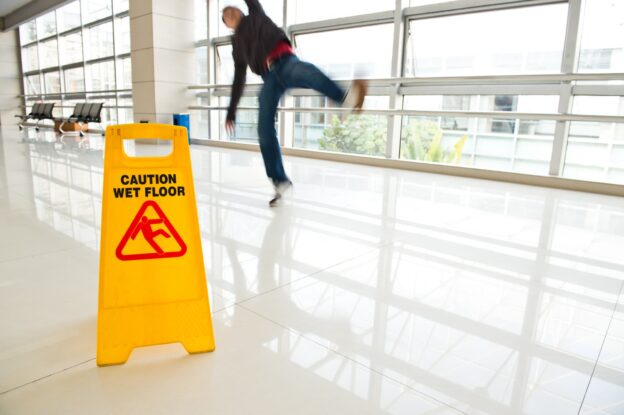According to the U.S. Department of Labor the majority of workplace injuries are a result of slips, trips, and falls. In fact, work-related injuries account for as much as 15 percent of all accidental deaths per year just behind car accidents. It is estimated that work-related injuries result in 65 percent of all lost workdays per year.
Types of Workplace Falls
It is important to understand the different types of falls a worker may face while performing the daily duties of his or her job. Generally, falls can be placed into three different categories: single level, lower level and swing falls.
Commonly referred to as “slip and falls” or “slip and trip”, single level falls occur on a generally leveled surface. Slips may occur as a result of temporary or permanent material coating on the floor’s surface or footwear tread issues. Trips, on the other hand, may be the result of an uneven or curved surface or by running into equipment or fixtures. Lower level falls occur when an injured person falls from an elevated surface to a lower one. The Occupational Safety & Health Administration (OSHA) requires that employers provide fall protection for workers in a setting where they may fall 4 feet or more to a lower level. Swing falls may include lower level falls when a worker is attached to a fall arrest system. Because often in swing falls the system’s attachment is not overhead, it results in the employee swinging back to the attachment point after a free fall.
Studies have shown that 66 percent of workplace falls are single level accidents, while 34 percent are lower level falls. When there is too little friction or traction between the victim’s footwear and the surface, a slip and fall will likely occur. On the other hand, a trip and fall often happens when someone’s foot hits or strikes an object, causing the person to lose his or her balance. Some causes of slips include occasional spills, wet or oily surfaces, loose or unanchored mats or rugs, weather hazards, and flooring with differing traction. Common factors contributing to a trip include poor lighting, obstructed views, uneven walking surfaces, clutter in the pathway, wrinkled carpeting or rugs.
There are different categories of workplace injuries. An injury is considered work-related if it occurred when the victim was doing something on behalf of his or her employer or otherwise within the course of employment. Injuries that may be classified as work-related include those that actually happened at the workplace, but may also occur in company-owned vehicles and other locations as long as the victim was doing something connected with his or her employment. Company parties, social events and other employer-sponsored gatherings that may not take place on company-owned property are also covered. Should an injury occur during a lunch break, it may still be considered work-related if it occurs at the company’s kitchen or cafeteria, on other employer-owned property, or if is otherwise connected to the employee’s course of employment.
Local Work Injury Attorney
No matter who is at fault for the workplace injury, someone who has been hurt on the job should always contact a Brooklyn slip and fall attorney if the injury is severe enough to cause you to miss work or causes pain and suffering while you attempt to continue working. Discussing your case with the knowledgeable legal professionals at the Law Office of Jeffrey K. Kestenbaum can help you understand your rights and obligations under the law. Click here today to schedule your initial, free, case evaluation.







